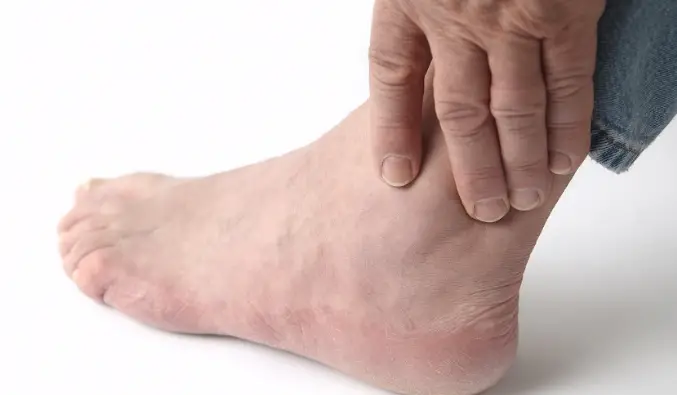The Most Common 3 Causes of Ankle Pain and Swelling
There most common causes of ankle pain with swelling: Tendonitis, Diseases, Fractures, and Sprain
Fractures and Sprains
Check out my Article
Tendinitis
Tendonitis is one of the leading causes of severe ankle pain. Tendonitis is the name given to the condition following an injury to a tendon (a thick, fibrous cord which muscles use to attach themselves to a bone) which involves irritation or severe inflammation. Tendonitis is a common condition, usually quite treatable, which can cause mild to severe pain and swell just outside of the joint where the tendon itself was sprained or fractured.
This condition, while a primary cause of ankle pain, can occur in the tendons located in almost any part of your body. Most commonly, tendonitis will tend to occur in the ankle, elbows, shoulders, heels, and wrists. Tendonitis is commonly known for other names, including golfer’s or tennis elbow, swimmer’s or pitcher’s shoulder, and jumper’s knee, these various names conveniently indicating the usual source of the injury.

As is commonly known, there are, in fact, hundreds of tendons located at various places within our body. However, it nearly always tends to be a handful of tendons located in a specific area which proves to the root of the problem (in this particular case, the source of the ankle pain). These faulty tendons tend to contain within them somewhere an area of acutely poor blood resupply. This lack of fresh, oxygenated, blood coming in to replenish the depleted area can lead directly to tissue damage and a subsequently poor healing response when it comes to injuries.
The area of the tendon which is prone to injuries, including those which frequently account for the source of ankle pain, is known as the “watershed zone“. This zone is an area in which the supply of blood to the tendon is at its weakest and most sluggish. When this occurs, your body has a rough time of it to deliver oxygen and other nutrients which are necessary to heal the injured area.
Ankle pain, as one of the common outcomes of a tendonitis injury, is frequently an “overuse” type of syndrome. When you begin a new, particularly strenuous activity you have not undertaken before, such as tennis, prolonged physical exercise, or long distance swimming, this can cause your tendons to be overstretched and thus inflamed or irritated. This cause of ankle pain strikes most often in individuals whose stage of life falls between the range of 40 to 60 years. Tendons, for these mature individuals, are not quite as elastic and stress-ready as they are for much younger people. It is wise for older individuals to keep these facts in mind when planning a regimen of fitness training, so as not to inadvertently increase the risk of a minor or major ankle sprain or fracture.
On some occasions, there may be a direct anatomical cause of tendonitis. If the tendon is malformed, or the bone it is attached to has been broken, it will not have a smooth, straight pathway to stretch itself out along. If this condition occurs, the likelihood of ankle pain as its direct result increases. This situation is uncommon and is usually treated with surgery which realigns the tendon along its correct path.
If your tendonitis injury is severe, and your ankle pain is acute as a result, you will need to seek the attention of a medical specialist immediately. However, most cases of tendonitis are far from severe, and can thus be treated informally with a bit of rest (staying off the injured ankle as much as possible, and placing no weight upon it), physical therapy, and medication which will reduce the pain associated with the injury. The keys to recovery are, as always, sound judgment, as well as judiciously administered simple common sense.
Diseases
There are a wide variety of conditions that can lead to the unfortunate development of frequently recurring chronic ankle pain, including disease. There are several known diseases and conditions which can cause ankle pain (both as a main condition in itself and as a symptom of another, related condition). The purpose of this part is to describe to the reader a number of these diseases and conditions that can bring on ankle pain, and enable him or her to determine the proper course of treatment to deal with them.
There are several sources of ankle pain which involve the development over time of inflammatory types of arthritis. Symptoms of arthritis in the region of the ankle can include (but are not limited to) gouty arthritis, reactive arthritis, ankylosing spondylitis, psoriatic arthritis, and rheumatoid arthritis. Contrary to what many may generally believe regarding the common sources of ankle pain, these arthritic conditions are not generally brought about by a specific, traumatic injury. In fact, these conditions may develop gradually, over the course of repeated injuries which may be minor in of themselves, and thus neglected and left untreated.

In the case of these arthritic sources of ankle pain, a thorough evaluation, including a series of blood tests, by a medical professional may ultimately be required to obtain a correct diagnosis of one’s condition. The above-mentioned sources of arthritic related ankle pain are known to give rise to many recognizable symptoms, including stiffness, redness, swelling, pain, and a feeling of uncomfortable warmth in the affected region. Each of these conditions has been shown to respond to a separate course of therapy and treatment, so the person living with constant arthritic ankle pain need not feel as if his condition is hopeless, or unmanageable.
There are other conditions that exist which can manifest in severe, recurring ankle pain. For example, tarsal tunnel syndrome is frequently observable in persons who participate in competitive sports such as racquetball, soccer, and tennis. Tarsal tunnel syndrome occurs as a result of nerve compression at the region of the ankle, which is caused by the nerve passing under the supportive band which surrounds the ankle, the flexor retinaculum, and becoming “pinched” or crushed as a result.
As far as becoming sources of ankle pain, infections are exceedingly rare, but occasionally do occur. Ankle infections are most commonly the result of a bacterial infection having been introduced into the ankle through puncture wounds, or a similar traumatic injury. Bacterial infections of the ankle can also develop through a breaking down of the skin due to ulceration or major abrasions or gashes. Individuals who suffer from auto-immune diseases such as AIDS are often at an increased risk of infection in many of the joints in their body, the ankle included. Persons suffering from diabetes, as well as those who may be required to take cortisone medications for previous injuries, are also at a heightened risk.
Bacterial joint infections, while a relatively uncommon diagnosis for the majority of persons who suffer from ankle pain is a matter of medical urgency when they do occur, Treatment of this particular malady will usually require a course of antibiotics, as well as drainage of the wound itself.
Chronic ankle pain can also manifest as the result of a viral infection. This condition, known as “toxic synovitis”, occurs most often in children. This condition results in a temporary inflammation of the joints and is normally first identified as causing limping. Toxic synovitis is normally resolved with symptomatic treatment for the relief of associated pain (for example, medications containing acetaminophen).
In conclusion, the causes of ankle pain are many and varied. If such pain is reoccurring or ongoing past a reasonable amount of time, medical help should be consulted immediately.
The Most Common 3 Causes of Ankle Pain and Swelling, Last Updated: 3/2/2018



Pingback: How To Tell if The Ankle is Broken or Sprained? - Body Pain Tips